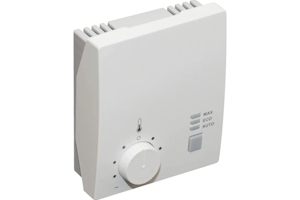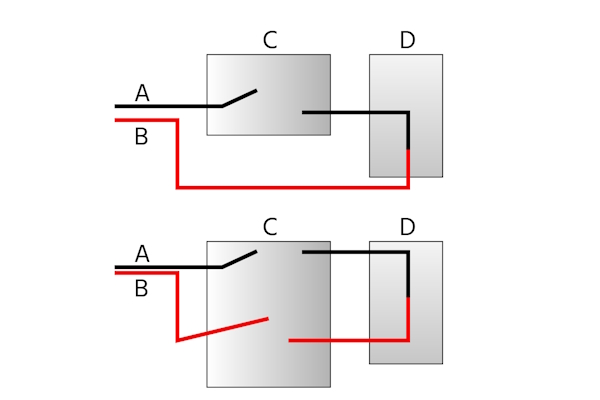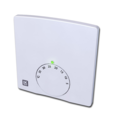HVAC Thermostat Types

Figure 1: A low-voltage hvac manual thermostat
HVAC thermostats are the control hub for HVAC systems, allowing users to set and maintain their desired indoor temperature for optimal comfort and energy efficiency. This guide overviews the distinctions among various thermostat types: line voltage, single and double pole, low-voltage, and technological advancements in manual, programmable, wi-fi, and smart thermostats. This understanding is crucial for selecting a thermostat that enhances home comfort and supports a more sustainable and cost-effective household environment.
View our online selection of thermostats!
Line voltage thermostats
Line voltage thermostats operate directly with the electrical system's standard voltage, typically 120 or 240 volts. They are directly wired to the heating units they control.
- Operation: These thermostats regulate temperature by interrupting the flow of electricity to the heater. When the room's temperature drops below the set point, the thermostat closes the circuit, allowing electricity to flow and generate heat. Conversely, when the desired temperature is reached, the thermostat opens the circuit, halting the heating process.
- Applications: Predominantly found in older homes and apartments, line voltage thermostats are suited for controlling electric baseboards, wall heaters, and convectors. Their straightforward design and direct control mechanism make them a robust choice for single-zone heating systems.
- Features: Line voltage thermostats are known for their simplicity and ease of installation. However, they generally lack their low-voltage counterparts' programmability and advanced features.
Single vs double pole line voltage thermostats
A single-pole line voltage thermostat has two interchangeable wires, making it easy to install, and one switch that opens or closes the circuit. However, single-pole thermostats must be constantly powered, even if this means taking power from the heating unit, causing it to periodically shut off or turn on, reducing efficiency.
A double-pole line voltage thermostat needs four wires to install, one of them being an L2 (N) wire. This means the thermostat can be powered even when no power is running to the heating unit, can be turned off, and does not steal any power from the heating unit.

Figure 2: Single pole (top) and double pole (bottom) line voltage circuit diagrams. Load 1 (A), Load 2 (B), thermostat (C), and heating unit (D).
Low-voltage thermostats
Low-voltage thermostats are more advanced than line voltage thermostats. They operate at a safer, reduced voltage, typically 24 to 30 volts. They are the standard for central heating and cooling systems, including furnaces, boilers, air conditioners, and heat pumps.
- Operation: Low-voltage thermostats send signals to the furnace or air conditioner to start or stop based on the temperature settings.
- Applications: These thermostats are versatile and compatible with various heating and cooling systems. They are mainly used in homes with central HVAC systems, offering precise temperature control across multiple zones.
- Features: Low-voltage thermostats have many features, including programmability, Wi-Fi connectivity, and compatibility with smart home systems. This allows for enhanced energy efficiency, remote control, and customization of heating and cooling schedules.
Selecting between line and low-voltage thermostats
The choice between line voltage and low-voltage thermostats depends on the specific heating and cooling system in place and the desired features and level of control. Line voltage thermostats offer a straightforward solution for electric resistance heaters. In contrast, low-voltage thermostats provide a versatile, feature-rich option for central HVAC systems.
Thermostat interface types
A manual thermostat with a dial may be what most people think of when they think of a thermostat. However, more advanced thermostat interface designs are becoming more common as technology advances. Table 1 overviews these different types of thermostats.
Table 1: Thermostat interface types
| Type | Overview | How they work | Benefits | Ideal for |
| Manual | Most basic type. Require physical interaction to adjust. | User moves a dial or lever to adjust the temperature. | Simple, reliable, and straightforward. | People who are often home and prefer direct control or properties without constant occupancy. |
| Programmable | Users can set temperature schedules | Users program different temperatures for specific times of the day or week. | Energy efficiency and convenience by automatically adjusting the temperature | Users with regular schedules who want to reduce energy consumption. |
| Wi-fi | Convenient. Allow remote control over heating and cooling via the internet. | Connect to the space's Wi-fi network. Users use a mobile device's app or a web interface to control the thermostat. | Remote access, ease of use, and the ability to adjust settings on the go. | Homeowners who travel frequently or those who want to adjust temperature before arriving home. |
| Smart | Advanced. Use learning algorithms and sensors to optimize heating and cooling patterns. | Learn from users' habits and adjust temperature automatically. Can sense when a space is empty. | Energy efficiency, convenience, and potential cost savings on utility bills. Can integrate with other smart home devices. | Environmentally conscious homeowners and those interested in latest automation technologies. |
FAQs
Are there different types of thermostats?
Yes. There are line voltage and low-voltage thermostats. Also, thermostats can be interfaced with manually or through more advanced technology, such as via the internet.
What is the most common type of thermostat?
The most common type of thermostat can differ from region to region. However, non-programmable thermostats with an LED interface are quite common.





